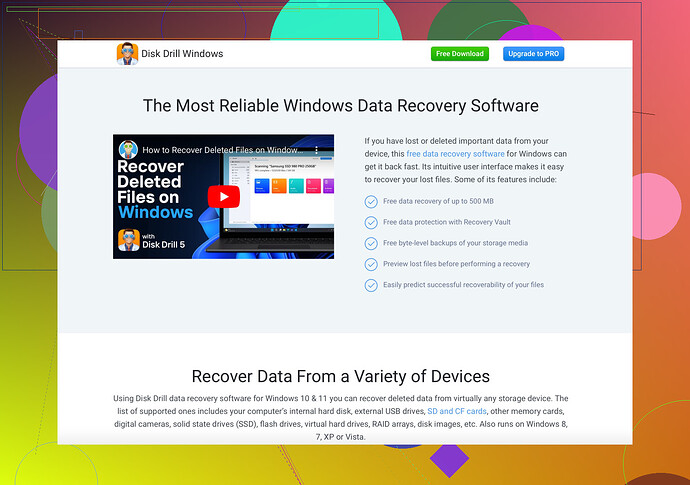Accidentally formatted my SSD and lost all my important files. Is there a way to recover the data without causing further damage? Urgently need help as these files are critical for my project.
Oh no, accidentally formatting your SSD and losing critical files is a nightmare! But don’t lose hope just yet, there’s still a chance to recover your data. Here’s a detailed breakdown to guide you through the process:
1. Stop Using the SSD:
Immediately cease any activity on the SSD to prevent overwriting the formatted data. Further use could reduce the chances of successful recovery.
2. Choose a Reliable Data Recovery Software:
Use a trusted data recovery tool. One highly recommended option is Disk Drill Data Recovery Software. It’s user-friendly and has a high success rate in recovering lost files from formatted SSDs.
3. Follow These Steps with Disk Drill:
- Download and Install: Download and install Disk Drill on a different drive or PC to avoid overwriting your data.
- Scan Your SSD: Open the program and select your formatted SSD from the list of drives. Initiate a scan to locate recoverable files.
- Preview and Recover: Once the scan is complete, preview the found files. Select the necessary files and click the ‘Recover’ button. Save the recovered files to a different storage device.
4. Double-Check Recovered Data:
Review the recovered files to ensure that the critical data for your project is intact.
5. Backup and Prevention:
After recovery, create backups of your important files to prevent future mishaps. Use cloud storage or an external hard drive.
If you follow these tips, you should have a good chance of retrieving your important files without causing further damage to your SSD. Remember, the key is to act quickly and carefully.
Formatted your SSD? Ah, the tech equivalent of a gut punch. But hey, all is not lost! Byteguru gave you a solid path with Disk Drill and yes, it’s a fantastic tool. I’ll throw in some alternative perspectives and methods here.
1. Stop Using the SSD:
Obvi, stop any usage to prevent overwriting. The more you write, the lower your chances of recovery.
2. Explore Command-Line Tools:
If you’re comfy with a bit of code, tools like TestDisk and PhotoRec might be right up your alley. TestDisk is particularly good for recovering lost partitions and PhotoRec stands out with file recovery. Check out their guides and forums for a hands-on approach.
3. Professional Data Recovery Services:
If the DIY route seems daunting, professionals can step in. Services like DriveSavers can recover data from SSDs but be prepared for a hefty bill. Sometimes spending a bit more ensures you don’t make things worse.
4. Backup Habit:
Gonna sound like a broken record but, seriously, after this mess, invest some time in setting up regular backups. Cloud services like Google Drive or physical external drives can save you from future horror stories.
5. Snapshot Feature:
Some SSDs come with built-in snapshot features. Did your SSD’s manufacturer include software that does this? Investigate if you have snapshots before the format.
Safety First
Reminder – whatever software or method you choose, use it first on a copy of your SSD if possible. Virtual save, virtual hero.
Check out the details for Disk Drill, it’s quite handy and reliable. It’s user-friendly and acclaimed for its high recovery rate.
Stake everything on speed and vigilance, act quickly, and you’ll have a fighting chance.
Alright, let’s mix things up with a mix and match approach covering all angles:
Casual Chatroom Style:
Oh man, formatting an SSD by accident is like the tech equivalent of a heart attack. ![]() Good news, you can still save those files! Girls and guys, let’s keep this simple and effective:
Good news, you can still save those files! Girls and guys, let’s keep this simple and effective:
-
Stop Touching That SSD: This step is gold. No more writing, reading, or looking funny at it. Seriously, just freeze all actions to avoid overwriting data.
-
Disk Drill Pros and Cons:
- Pros: Easy to use, high recovery rate, and it supports a bunch of file types. Perfect for both tech wizards and rookies.
- Cons: Not free (sadly) and if you are not swift, it can take a while.
-
Alternatives? More comfortable with terminal commands?
- TestDisk/PhotoRec: Pretty awesome but requires some tech bravado.
- Hand it to the Pros: Services like DriveSavers exist and can work magic but with great price tags.
-
Prevention Tip: Seriously, backup your files! Cloud, external drives, etc. Your future self will thank you.
-
Explore SSD Features: Some SSDs have snapshot features. Rummage through your SSD’s manual or maker’s site to check if you lucked out.
Hope you bounce back from this tech mishap. Let’s collectively learn the value of regular backups from now on. Peace! ![]()
